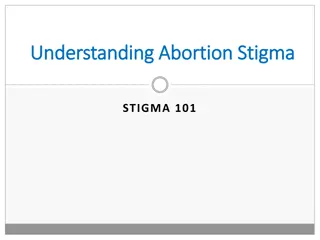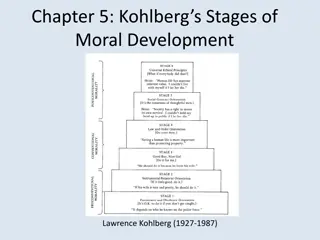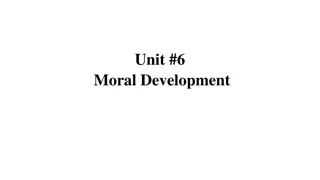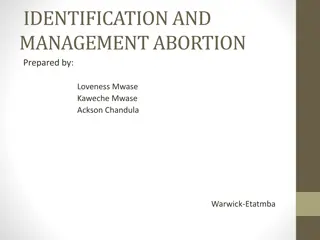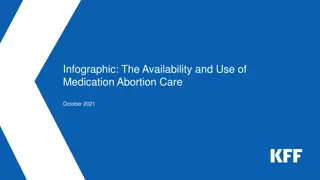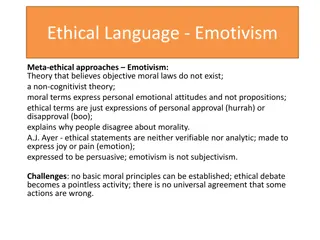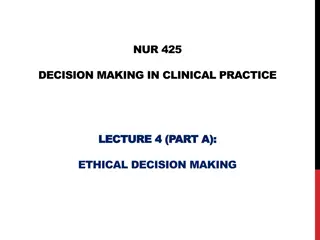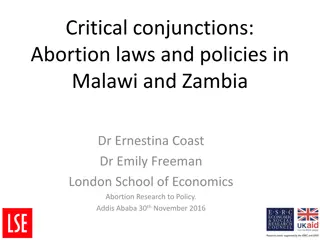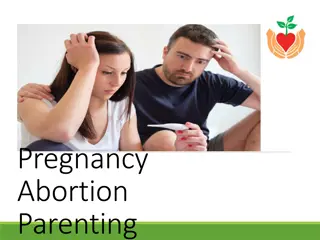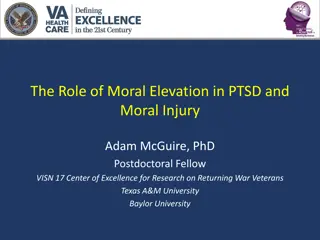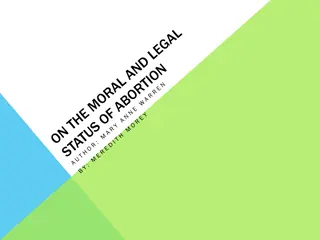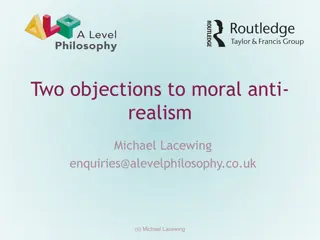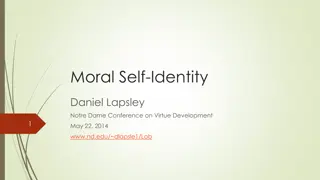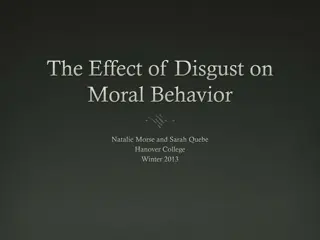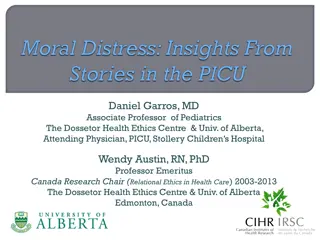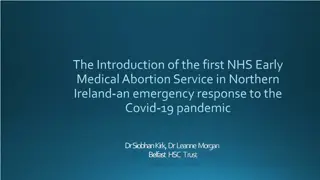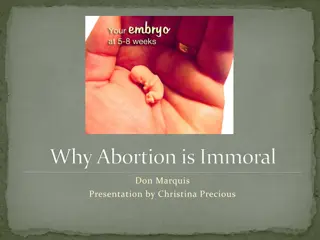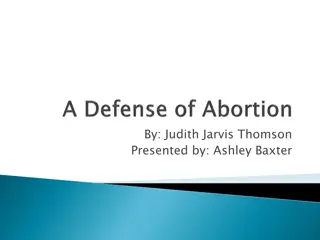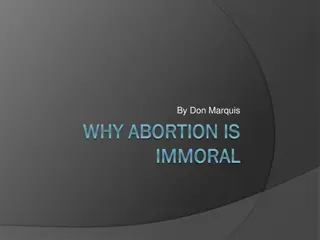Understanding the Moral and Ethical Aspects of Abortion
Abortion is the termination of a pregnancy, raising moral and ethical dilemmas. Types of abortion include medical and artificial methods, legal considerations, and medical indications for termination. Social reasons for abortion include court decisions, rape, imprisonment, disability, or spousal death during pregnancy.
Download Presentation

Please find below an Image/Link to download the presentation.
The content on the website is provided AS IS for your information and personal use only. It may not be sold, licensed, or shared on other websites without obtaining consent from the author. Download presentation by click this link. If you encounter any issues during the download, it is possible that the publisher has removed the file from their server.
E N D
Presentation Transcript
http:// www.ibbm.unn.ru/ o-fakultete/ struktura/kafedry/ kafedra-fiziologii-i- anatomii/
Moral and ethical problems of abortion Prof. Tzibusov Sergey Nikolaevich
https://thepresentation.ru/img/thumbs/ec5c1accd944326ebc9068e0dceec1e8-800x.jpghttps://thepresentation.ru/img/thumbs/ec5c1accd944326ebc9068e0dceec1e8-800x.jpg
What is abortion Abortion is the termination of a pregnancy before the term when it can be completed with childbirth. The bioethical problem of abortion is to justify the moral admissibility or inadmissibility of abortion as a practice of intervention in human life at the stage of intrauterine development
TYPES OF ABORTION medical science, artificial abortions are distinguished. Spontaneous abortion (miscarriage) - this phenomenon belongs medicine and is not biomedical ethics research. Artificial termination (abortion)is the process of using medical technology to interrupt the natural course of the pregnancy process in a woman's body. spontaneous In and to the field of of the subject of pregnancy
TYPES OF ABORTION In the sphere of the law, there are legal and criminal performed in accordance with norms of the current legislation or violating it. According to the legislation in force in our country, there abortions at the woman's request , for social reasons and for medical indications . abortions, i.e. the
Medical indications for the termination of the pregnancy: Infectious and parasitic diseases (all active forms of tuberculosis, viral hepatitis, syphilis, HIV, rubella) Neoplasms Diseases of the endocrine system (diabetes mellitus complicated forms, pheochromocytoma, toxic goiter, etc.) Diseases of the blood and hematopoietic organs Mental disorders (psychosis, psychotic conditions, chronic alcoholism, substance abuse, mental retardation)
Termination of pregnancy for social reasons: a court decision on the deprivation or restriction of parental rights, pregnancy after rape, a woman s stay in prison, disability of 1-2 groups or the death of her husband during pregnancy
The greatest number of ethical issues arises in connection with abortions performed at the woman's request and for social reasons, since in this area the freedom of a person to intervene not only in the natural processes of human life, but also in the spiritual, social life of a person, in the area of his rights and freedoms. is most manifested
According to the Law No. 5487-1 of22 July 1993on Fundamentals of Russian Federation Legislation on Public Health Care every woman has the right to decide independently the question of motherhood. Artificial abortions are performed at the woman's request within the first 12 weeks of the gestation period, when socially indicated within 22 weeks, and any stage of pregnancy whenever medically indicated and with the woman's consent.
Unwanted pregnancy Cheap expencive
Each year more than 75 million women worldwide experience an unwanted pregnancy. About two-third of them end in abortion. Of the 45 million abortions performed in the world every year, Russia accounts for about 2 million (according to official statistics)
Some statistics 53% of adolescents begin to have sex at 15-17 years; every tenth abortion is performed by girls aged 14 years and girls aged 15-19, years; every second abortion is performed by young women aged 20-29 years; The number of abortions in adolescents fewer than 14 years old within 22 weeks of the gestation period is increasing. More than 40% of first pregnancies are terminated by artificial abortion.
MEDICAL ABORTION Dilation and evacuation during a late stage of gestation This procedure takes three days. During the first two days, the cervix is widened; the woman is given antispasmodic drugs. On the third day, the woman takes a medication that provokes childbirth. Once the birth has begun, the doctor does an ultrasound to locate the baby's legs. Forceps are used to grasp and pull the legs, shoulders, and arms through the birth canal. A small incision is made on the base of the skull to allow a suction catheter inside. The catheter removes the cerebral material until the skull collapses. The fetus is then completely removed.
According approximately women worldwide perform abortions annually, i.e. 21% of all pregnancies terminated artificially. same abortion statistics show that about women die each year from various resulting from Every fifth woman becomes infertile as a result of the first abortion. to statistics, million 55 are The 70 thousand complications abortions.
The abortion reduced criminal abortions, but so far, for a reasons, women, especially girls, are terminate their pregnancy secretly, inappropriate Such termination pregnancy usually with incomplete removal of the fetus, bleeding, damage to the uterus, which can lead consequences, even death. legalization statistically the number of has of number of trying to under conditions. of ends and to serious
LEGAL NORMS According to international standards, everyone has the right to have children, to be healthy and to make decisions on these issues independently. If we consider the moral problem of abortion from a scientific point of view, especially bioethics, researchers prioritize the issue of the status of the embryo. then the
HISTORY OF SOCIETY'S ATTITUDE TO ABORTION The first position Hippocratic Oath. Among the many medical manipulations, Hippocrates specifically singles out abortions and promises: "I will not give to a woman a pessary to produce abortion." So Hippocrates fixes the position of the medical profession inadmissibility of the participation of a doctor in the production of an artificial miscarriage. is expressed in the ethical on the
Another opinion - the opinion of the legislators of Ancient Greece on the natural expediency of abortion is summarized and Aristotle, who wrote in Politics : "When couples have children in excess, let abortion be procured before sense and life have begun. " expressed by
Later in the arsenal of the liberal ideology there is the principle of "a woman's right over her own body" or "a woman's right to control her body."It is very difficult to make a decision especially for a truly spiritual person. Different religions interpretations of this problem. But it should be noted that condemn abortion and consider it murder. regarding abortion, have different most religions
PROBLEM THROUGH THE EYES OF BELIEVERS A large part of Russia's population is Orthodox Christians. From the point of view of the Orthodox faith, the moral issue of abortion is not as simple as it might seem. However, it is quite clear, that the Christian Bible Scripture says: "By killing unborn children, women destruct God s sacred creation .
DEMOGRAPHICS AND POVERTY LINE The demographic position of the country, together with the economic factor, is also another point in assessing the morality of the abortion problem. In Russia, there is only minimal support for significantly undermines the status of the family. The largest mass group of the poor is families with children; they make up 50-60% of the total number of poor families. mothers, which
Every day in the world about 100 million sexual acts are performed, in 910 000 cases conception occurs, in 10% of these cases pregnancy ends with abortion. At the moment, concern is caused by both the medical consequences of abortion- maternal morbidity infertility) and mortality, and moral and legal-the problems of its admissibility in the early stages legislative regulation. (often leading to of pregnancy and
The most important element of this argument is the statement: the embryo is a human being. This argument is perceived at the level of simple everyday observation evident, not requiring any special evidence. The well-known according to which a person s age is counted from the moment of conception, and not from the moment of birth, speaks in its favor. as self- Eastern tradition,
Such scientifically established facts are cited as the fact that a human embryo of a rather early age, already at 9 weeks, has a face, fingers, intracerebral activity, etc., or that, moreover, the main features personality are already programmed in the gene. Therefore, circumstances can abortion be morally justified. of the human under no
And since the right to life is an inalienable right of any human being, the emryo also has such a right. Hence, abortion is unacceptable from a moral point of view, abortion should be prohibited (in those countries where they are allowed) and in no case should be allowed (if it is currently prohibited in this country).
A mitigated anti-abortion position is considered to be one which, in principle, considers unacceptable, but as an exception, in cases where there are medical indications, or in the case of rape, allows it. abortion
The very admissibility of exceptions is argued by the need to take into account the desire and interests of the mother. In the first case, where there are medical indications, the mother s right to life (and health) is violated. In the case of rape there is no voluntary consent of the woman. After all, mother is a person; she also has the right to life, health, freedom.
Proponents of legalizing abortion give the following arguments: 1. Even if the embryo is a human being, one cannot help but see the difference between the embryo and the person. This difference is recognized even for a plant: the difference between a seed, a sprouted germ, and an adult plant. Even in the case of a plant, it is recognized that acorn and oak are not the same thing.
2. Even opponents of abortion admit that this creature needs the mother precisely because it is not independent, autonomous, cannot develop outside the mother s body, but must exist within it for nine months. Therefore, before it is born, it is not yet independent, and the act of birth determines exactly the moment when it becomes autonomous. That is why birth becomes the beginning of human life.
In most secular states, it is believed that a woman's bodily autonomy gives her the right to control her body, and the emergence of a new personality with rights occurs at the moment of birth. Therefore, abortion is allowed in all these countries.
Orthodox Since Church considers intentional termination of pregnancy (abortion) as a grave sin. Canonical rules equate murder. The Church sees the widespread and justification of abortion in modern society as a threat to the future of mankind and a clear sign of moral degradation. Under no circumstances can the Orthodox Church bless abortion. ancient times, the abortion with
The Catholic Church believes: "From the very beginning, the fetus should be revered as a person." The official documents of the Roman Catholic Church prohibit abortion, even for health reasons (Encyclical Humanae Vitae of Pope PaulVI, 1968; Charter for Workers, 1994). Health Care
In Protestant churches, abortion is condemned as a means of birth control, but is exceptional situations, for example, during pregnancy (Consensus Statement on Abortion of the Seventh-day Church, 1990, etc.). allowed in after rape Adventist
code of medical Islamic . ethics (Kuwait, 1981)condemns current trends in abortion authorization. In particular, it says: The sanctity of human Life covers including intrauterine embryo and fetus. This shall not be compromised by the Doctor save for the absolute medical recognized by Islamic Jurisprudence. all its stages of life the necessity
Buddhism teaches that to kill is to commit the most terrible negative act. The ethics of Buddhism begin with the commandment:"abstain of taking of human or animal life." "The embryo is sacred and carries the full potential of the human being." Therefore, abortion corresponds to the destruction of life regardless of stage."
According to the authorities of Judaism, abortion (and generally unwillingness to have children) is contrary Messianic destiny of the Jewish people. At the same time, authoritative Jewish Maimonides taught: not to have pity for the life of an aggressor. Referring to this principle, Dr. Shabad authorized the killing of a child in the womb if continuing the pregnancy would threat mother s physical or mental health. to the history and one theologians of the most doctor
So, based on the foregoing, we can conclude that all religions see in the embryo the human consider abortion a murder regardless of age. being and gestational
The history of abortion in Russia is instructive. For the first time in the country, abortion at a woman s request was allowed in 1920. At that time, Russia was the first and only country in the world to have such liberal abortion legislation. Until now, Russia Netherlands, Sweden and the USA) is the country with the most liberal legislation on artificial abortion in the world. (along with the
According to statistics, in Russia up to 15% of operations give complications, about 8% of women remain infertile. Currently, about 7 million Russians cannot experience the happiness of motherhood, and the reason is performed earlier abortion. According to the research Institute gynecology and perinatology, 2.3 million abortions annually in Russia, in 10% of cases these operations end in infertility. of obstetrics, are registered
In the dispute of two principles, one based on the mother's right to choose and the other-on the fetus right to life, there is one contradiction that makes it impossible to resolve it. The fact is that the principle of the right to choose applies equally to the fetus and to the woman herself. As a result, the dispute becomes purely scholastic. Such disputes are not particularly attractive. It is necessary to find a practical solution to the really complex and internally contradictory problem of abortion, and it is the use of contraceptives.
THANK YOU FOR ATTENTION!



